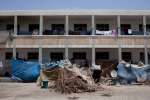Shelter Assistance to Displaced People in Kunar
Crisis in Afghanistan, 19 January 2009
UNHCR Kabul Press Information, 19 January 2009
KABUL, Afghanistan, 19 January 2009 – Recognizing the need for assisting the displaced families from Bajaur Agency of Pakistan currently residing in Kunar, UNHCR has initiated the implementation of some 900 one room shelter programme for vulnerable displaced families. The one room shelters are an extension of rooms in the compound of the host families or in the compound where the displaced families are staying.
Some 2,570 families remain displaced from Bajaur Agency of Pakistan's Federally Administered Tribal Areas (FATA) in Shigal, Marawara and Dangam districts of Kunar province in eastern Afghanistan.
The total number of one room shelter assistance is nearly 900 units. In addition around 50 extremely vulnerable and larger families will be assisted with two room shelters. The implementation of one room shelter has already started. In addition 120 tents have been distributed to displaced families that did not have sufficient space for the construction of one room shelter.
The displacements began when Afghans and Pakistanis fled fighting in Bajaur Agency in mid-August have placed great pressure on the capacity of the host families.
According to the assessment conducted by the local Department of Refugees and Repatriation (DoRR) and UNHCR's Implementing Partner (IP) in Kunar, some 800 displaced families have so far been identified as being in need of one room shelter assistance.
The implementation of the one-room shelter activity is also closely coordinated with DoRR Kunar and the Provincial Governor. The construction of the one room shelter is conducted by the displaced families and is expected to be finalized by the end of January or the beginning of February.
In parallel to the shelter assistance, the beneficiary selection of the winterization programme is ongoing in cooperation with DoRR Kunar and UNHCR IPs, targeting the vulnerable displaced families. UNHCR distribution of winterization items, in Eastern Afghanistan, already started and is expected to be completed by 20 January 2009.
An estimated 500 families have also been displaced from Muhmand agency, bringing the total number of displaced families to more than 3,000. Most of the displaced families are staying with their relatives benefiting from the support and willingness of the host families, while some are staying in old abandoned houses.












































